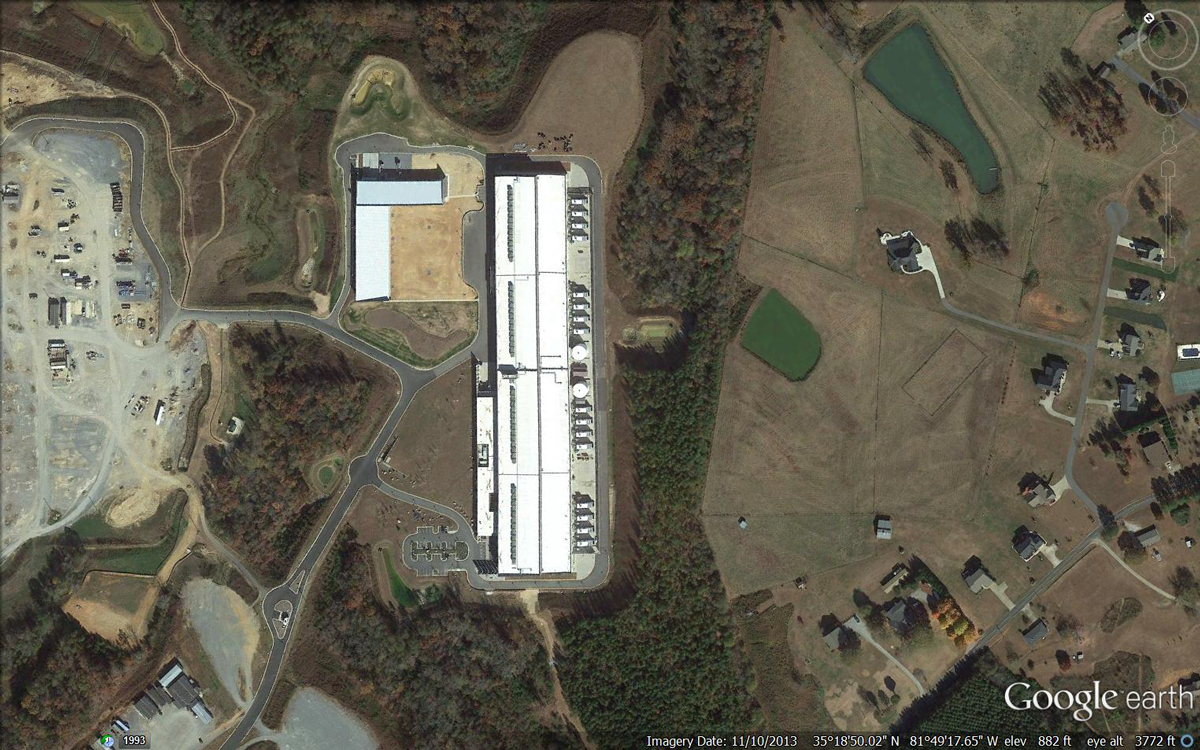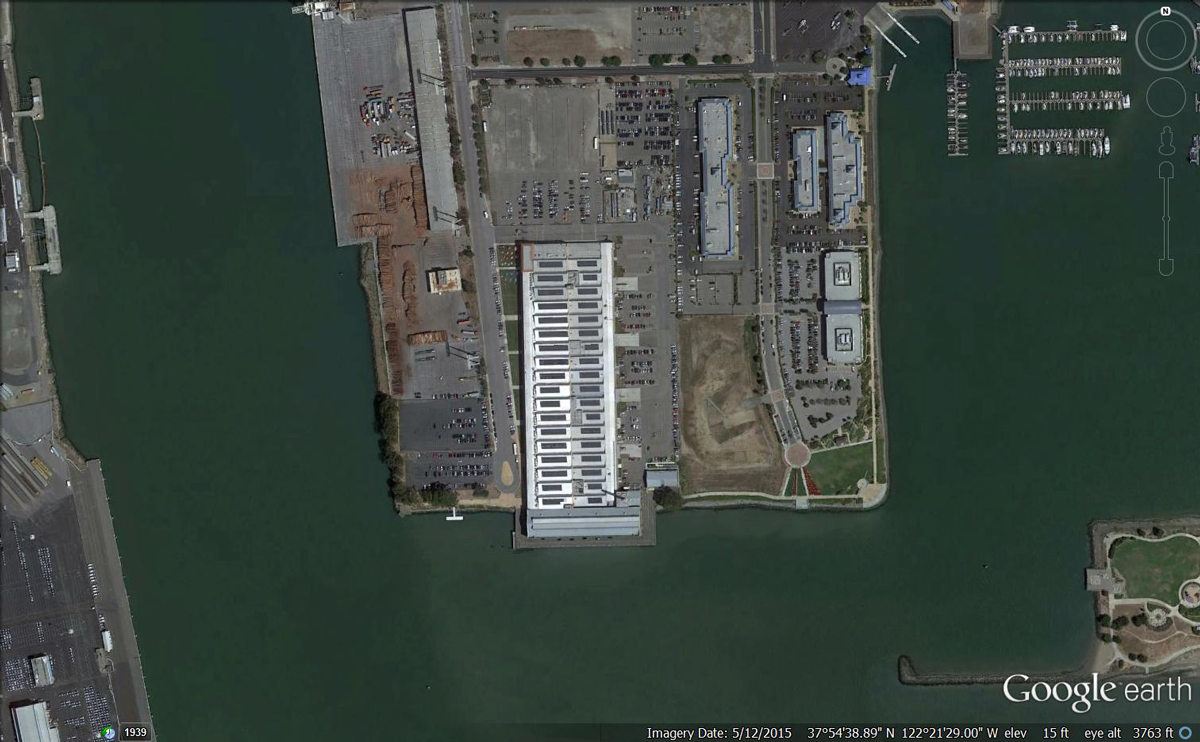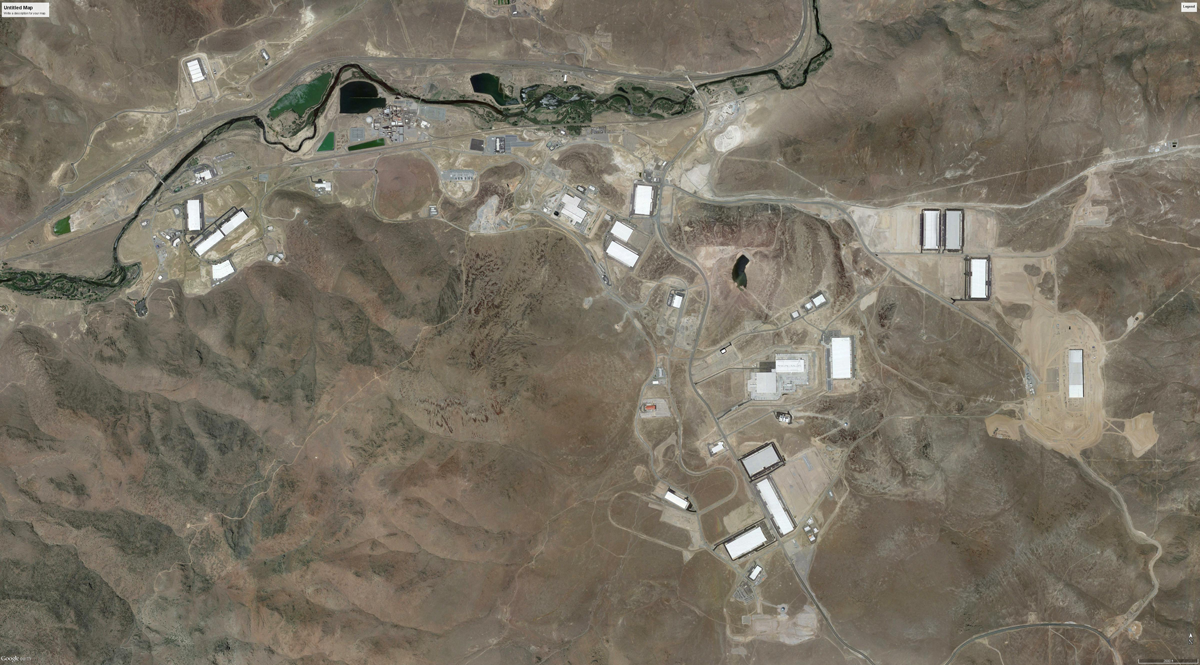
Facebook Data Center (opened 2011—45 workers when in operation). Courtesy Google.

Ford Assembly Plant (opened 1931—2,600 workers when in operation). Courtesy Google.

Tahoe Industrial Park. Courtesy Google.
[](#)[](#)
The Paste
Imagine the scene 20 or 30 years from now. It is mid-morning, and the tourist buses have started to arrive. To the north and southwest are mountains, which rear up in pointed, shadowy curves from the flatness of the plain. To the south and east is desert, stretching into the liquid haze of the horizon. Here and there are thick groves of dark-green palms.
All of this landscape seems to look inwards, to the crowds now spilling excitedly out from behind the comfort of their tinted windows and their padded, air-conditioned seats. Very soon the chatter dies down, replaced by the clicks and whirrs of camera shutters and smartphones. This pause is staged. The tour operators let them stand for a minute or so, to look on in wonder. After all, what they see in front of them was supposed to have been obliterated by war. It should not be here. But it is here, rising up triumphant, gleaming in the sun, its stones already radiating the heat of the day: the ancient Syrian city of Palmyra.
At a signal, local guides descend on the groups and the silence is broken. There is a clamor for business, a babble of competing voices offering ‘the best tour of Palmyra’ and ‘the real tour of Palmyra.’ The tourists lap it up. They’ve read about this place, they’ve seen it on the news. Many of them remember its destruction years before at the hands of a violent terrorist organization: remember how, at the midpoint of the second decade of the twenty-first century, the world watched in impotent horror as a group calling itself Islamic State attacked the near 1,900-year-old city with chisels, sledgehammers, pneumatic drills, machine guns, and high explosives.
Destruction was not the end of Palmyra’s story however. There was a twist. This is why visitors are coming back here again from across the globe. They have traveled to celebrate and experience a unique triumph of architecture over adversity—or more accurately, architecture over annihilation.
As the groups trot off behind their chosen guides, the well-rehearsed monologues begin, each account embellished with slightly different details and choice pieces of anecdotal gossip. But the basic story is the same: the world fought for Palmyra. Not with guns and soldiers (at least not at first), but with technology and innovation. The idea was simple: to amass as much information about the city as possible before it was destroyed. Thousands of 3D cameras—designed by the Institute for Digital Archaeology (IDA) in Oxford and manufactured in China—were seeded throughout the region, making their way into the hands of local volunteer photographers. The cameras were small and lightweight, yet at the same time robust and hard-wearing, with extra-long battery lives and enhanced file storage capacities. They came with instructions—online and hardcopy—explaining how to get the best results when using them in the field.
Many Syrian men and women risked their lives taking photographs of Palmyra—and finding internet access in the midst of a civil war to upload the results. They achieved exactly what Roger Michel, the director of the IDA, hoped when he first announced the launch of this audacious plan: “By placing the record of our past in the digital realm, it will lie forever beyond the reach of vandals and terrorists.”
If we reduce it to these binary terms, the battle for Palmyra was a race of copying against deletion. For the first time, there was the capacity and the technology to take an entire physical site, and press \[CTRL-C\]. The timing—and the ultimate success—of this plan was critical for the future of the city.
Palmyra had been erased from the desert. But the \[CTRL-C\] Palmyra, accurate to every crack and crevice in every arch, column, and colonnade, lived on—literally a city in the cloud(s), just waiting to be 3D printed back into place. The tourists had come to Syria to witness a reincarnation: Palmyra \[CTRL-V\]’d.
The rebuilding is, of course, a fantasy: a narrative created out of a great long line of ‘what ifs.’ Ironically though, of all the hypotheticals, one of those that seems the most far-fetched—the wholesale 3D printing of an ancient city—is perhaps the most likely to actually happen. We already have the technological capability. The IDA is a real organization and its mission using volunteer photographers to capture a digital Palmyra, and many other sites throughout the Middle East and North Africa, is already underway. We can only guess at how much more sophisticated the technology will become over the next half-century or so. As for the fall of Islamic State and peace in the Middle East? That—now more than ever—seems like a fairy story. Let’s suspend disbelief, however, just to indulge in the hypothetical.
If the opportunity did arise to rebuild Palmyra, either in part or completely, should we? What would be our reasoning? ‘Just because we can’ or—to invert Edmund Hillary’s famous comment on climbing Mount Everest—‘because it isn’t there,’ seem insufficiently compelling arguments. Think of how you might feel if you were one of the visitors to the ‘pasted city’ of Palmyra 2.0. Imagine making the journey northeast out of Damascus—passing the rubble of countless modern buildings destroyed by the civil war, still neither cleared away nor reconstructed. Might these sorry sights not temper your enthusiasm just a little for your visit to a newly rebuilt city that no one lives in, and that no one has lived in for over half a millennia? I have no doubt that walking its 3D-printed streets would inspire awe. But awe for what, or for whom? Not, I suspect, for the history of Palmyra. More likely, it would be awe for our own human cleverness.
What we often forget is that buildings are imprinted with the personalities of their original creators and inhabitants. They are the products of specific moments in history, wrapped up in human emotions, beliefs, ambitions, prejudices, and personalities. You could compare the creation of a building to a piece of performance. Structures’ souls are formed by the circumstances of their births and their early lives. Context is everything. You had to be there. And because—particularly in the case of buildings that have survived from antiquity—we were not there, our experience of knowing them and visiting them is saturated with longing. That is their power. Our greatest buildings are like The Beatles on the Ed Sullivan Show, or Bob Dylan at Newport, like the first hang of Jackson Pollock’s “No.5” at the Betty Parsons Gallery, or Marlon Brando debuting _A Streetcar Named Desire_ on Broadway. We venerate the special alchemy of people, place and time that gives certain buildings their enduring appeal and significance. Yes, we can copy, recreate, restore, rebuild—but we can never recapture. And nor should we.
In the late 1970s, theorists in the field of robotics coined the phrase ‘the uncanny valley.’ It suggested that, as machines evolved to look and behave more and more like human beings, a stage would be reached of such near-but-not quite similarity that it would provoke feelings of unease or even revulsion. The brain would respond to these attempts at facsimile, these ‘almost’ human counterparts, the same way it would respond to the sight of a visibly diseased person or a corpse—with alarm and disgust. I suspect this also applies to buildings. The innate danger of reconstruction is that we, even if only subconsciously, become aware that we are being tricked. What more tragic end could there be for Palmyra than its transformation into an ‘uncanny city?’ What if good intentions combined to create something we cannot look at, because of how it makes us feel? Before long, the tourists visiting ‘New Palmyra’ might find their enthusiasm drained away by some non-specific, creeping dread…
Of course, this already happens today in some of the world’s most famous ancient sites. The Forum of Rome, Ephesus in Turkey, and even the Parthenon of Athens have all experienced varying degrees of modern reconstruction. Most notable of all is Knossos on the island of Crete. At the start of the twentieth century this 3,000-year-old palace, perhaps the site of Europe’s earliest civilization, was partially rebuilt in reinforced concrete by an over-zealous English antiquarian. It prompted the scathing comment from the historian R. G. Collingwood in the 1920s that: ‘the first impression on the mind of a visitor is that Knossian architecture consists of garages and public lavatories.’ We have never been able to resist the impulse to tinker with ruins—to attempt to reassemble the jigsaw of fallen stones. It is a natural response. It is also the wrong response.
For humans, there is no returning from death (let’s put aside any theological arguments here...). While this pains us—deeply and sometimes life-alteringly—we have no option but to accept the fragility and impermanence of our own flesh and blood. Buildings, however, tease us with possibility. If, as some argue, we have the plans, the materials, and understand the techniques, why shouldn’t we raise up our finest works of architecture from the dust? What is the harm? Well, potentially, the harm is very great. This kind of recreation—however well meant—flirts with something that makes historians very queasy: denial. Who are we to rewrite the life story of a building and ignore the facts of its death by putting blown-apart pieces back together, or even worse, building anew?
So far, the world has recoiled at the prospect of human cloning. One, among many, of the reasons for this, is that we understand that the copy is a falsehood. Yes, the DNA may be exactly the same, but it is impossible to recreate the circumstances that created the individual: all of the countless influences and experiences that build personality. We find the prospect of meeting our exact alter-egos so terrifying that it has become a well-mined seam of dystopian science fiction and gothic horror. (Interestingly, one of the early criticisms of the Twin Towers was that, as the French theorist Jean Baudrillard put it “they were clones of each other.” The American architect Charles Jencks equated the ‘extreme repetition’ of their design to a form of “mental torture.” Baudrillard continued by suggesting that the presence of two identical towers contained the threat of more—as if they might multiply unstoppably outwards. “It’s the end of the city” was his fatalistic verdict).
We should accord buildings the same respect as people. Let them rest in peace and in pieces. But do not forget them. We must continue to tell their stories, continue to celebrate, or at least understand, their lives and their deaths. Think, for instance, of structures like the Bastille and the Berlin Wall. Their enduring significance and power come from their destruction. Their ends were transformative. Symbols of control and oppression became—in the very instants of their fall—symbols of peace and humanity. The Bastille in particular is a global universal touchstone (with no stones left to touch) for the rights of man and the will of the people. The very idea of reconstructing it would be perverse. It is gone forever. And in its absence it remains one of the most important buildings in all of human history. (Ironically, the opposite may be true of the Berlin Wall. In the immediate aftermath of the collapse of the border between East and West, the cry went up that ‘the Wall must go!’ Some, like Dr. Alfred Kerndl, at that time Berlin’s chief archaeologist, considered the motives suspect. “It is typical for us Germans that at the end of an historical era we want to rip everything down and forget it ever happened,” he said. “It occurred with the Nazi sites, now it’s happening with the Berlin Wall.”)
These are structures of the (comparatively) modern world, their biographies telling us about our ongoing societal struggles over civil liberties and personal freedoms. But we have always told stories about our buildings. _The Epic of Gilgamesh_—the earliest known work of literature, inscribed on clay tablets over 4,500 years ago—is, in essence, a story about the power of architecture. It tells of the Mesopotamian king Gilgamesh and his quest to confront the gods and discover the secret of eternal life. It is a doomed venture—he learns that death is inevitable, beyond even the power of the gods to change. Downbeat and exhausted, he returns to Uruk, the city he has built for his people. As he looks up at its great walls he experiences an epiphany. Yes, man’s time on earth is short, but in buildings his name can live on through the ages…
Architecture has always been inextricably linked with the natural human preoccupation with legacy. Creation on a grand scale brings fame. But then so too does destruction. The great Temple of Artemis—one of the original seven wonders of the ancient world—was burnt to the ground by a man who saw it as the way to ensure his name was etched forever in history. (I’m not sure he succeeded though. How many of us have heard of Herostratus the arsonist?). When you strip away the many facile justifications for attacking buildings you are left with a basic, unchanging motive. Destroying them is about destroying culture. It plays on the symbolic eradication of a way of life, turning to dust all those artistic, political and social influences that give a building its soul. It makes those who hold a structure dear confront not just the fragility of their own lives, but of their entire society and civilization. When civil war engulfed the eleventh century Islamic kingdom of Al-Andalus for instance, it prompted Muslim scholars to recognize for the first time the mortality of their all-conquering religious empire. As the polymath Ibn Hazm wrote “It was as though the graceful palaces and embellished chambers that were as radiant as the sun…now that ruin and utter destruction was all around, were as the gaping mouths of wild predators announcing the annihilation of the world.”\*
You can follow the destruction of our greatest buildings like a line of falling dominoes crashing down through the millennia—and all set in motion by the same malicious hand. In this too is the spectre of ‘copy and paste’—with the terrifying addition of ‘delete.’ History marches to the metronomic, repetitive beat of rise, decline, and fall. The militants of Islamic State are just the latest in a long, long line of plagiarists of architectural devastation.
Let’s come back to Palmyra, though, and to the idea of a digital city held in file folders scattered across numerous servers, hard drives, and data centers. And let’s think about what might happen if Syria remains unstable for decades, caught in the horrible limbo of a permanent warzone? When we copy, we often do so to move something to somewhere else. How tempting would it be to relocate Palmyra to an entirely new site?
When the German Oriental Society excavated the ancient city of Babylon at the beginning of the twentieth century, they transported hundreds of tons of material back to Berlin’s Pergamon Museum. Once there, individually numbered blue-glazed bricks were cleaned and restored, and used to reconstruct completely the ‘Ishtar Gate’—once the entry point to Babylon’s sacred temple precinct. In the process the museum curators discovered an inscription attributed to King Nebuchadnezzar explaining that he had created his city gates ‘so that people might gaze on them in wonder.’ And so they do, once again—but thousands of years later and thousands of miles away, on an entirely different continent, and set inside a great work of twentieth century architecture.
A 3D-printed Palmyra could conceivably be recreated anywhere. It could be spread across the museums of the world: a colonnade here and an architrave there. Or it could be pasted wholesale into a new landscape. Why not plonk it down in the Nevada desert? Or stick it out in the empty tundra of Iceland? Why stop at just one copy? We could indiscriminately paste Palmyra everywhere, like an architectural stamp of defiance. And, I fear, with every \[CTRL-V\], the real city would recede further and further into obscurity. As Charles Jencks once wrote, quoting Oscar Wilde, “‘experience is the name we give to our mistakes,’ and there is a certain health in leaving them judiciously scattered around the landscape as continual lessons.” Maybe Palmyra should be one of those lessons—a scar for the world to bear. If it is to be lost, then we must endure the pain. We must accept collective responsibility. And we must do better.
_James Crawford’s latest title_ Fallen Glory: The Lives and Deaths of Twenty Lost Buildings from the Tower of Babel to the Twin Towers _is available from Old Street Publishing._
**\*** [Ruggles, D. (2000). _Gardens, landscape, and vision in the palaces of Islamic Spain_. University Park, Pa.: Pennsylvania State University Press.](http://www.amazon.com/Gardens-Landscape-Vision-Palaces-Islamic/dp/0271022477)
